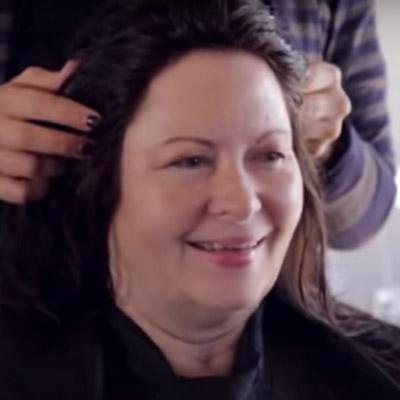- ALDACTONE: Brand name for spirolactone, a prescription high blood pressure medication that is also prescribed to treat women's hair loss.
- ALOPECIA: Loss of hair as a result of illness, functional disorder, or hereditary disposition. The medical term for hair loss.
- ALOPECIA AREATA: A disease that causes the body to form antibodies against some hair follicles. It can result from such factors as stress, genetics and the immune system. Alopecia Areata causes sudden smooth, circular patches of hair loss. The bulb of the hair follicle is attacked and therefore it is possible that hair can regrow under certain conditions.
- ALOPECIA REDUCTION: A procedure that involves removal of a strip of balding upper scalp in the crown and vertex areas. The natural flexibility of the scalp is used to stretch the surrounding hairy scalp into place. It can be repeated in certain cases. See also "Scalp Reduction."
- ALOPECIA TOTALIS: A condition that results in no hair on the scalp. It may begin as Alopecia Areata or some other cause.
- ALOPECIA UNIVERSALIS: A condition that results in no hair on any part of the body, this includes eyelashes, eyebrows, and scalp hair. It may develop as Alopecia Areata or result from another cause.
- AMINO ACIDS: The building blocks of protein. A deficiency of amino acids may adversely affect hair growth.
Amortization: The process of converting one enzyme to another, such as Testosterone to Dihydrotestosterone. - ANAGEN: The growing phase of hair, usually lasting between one and seven years.
- ANAGEN EFFLUVIUM: Loss of hair that is supposed to be in the anagen or growing phase. This is the type of hair loss that is associated with chemotherapy or radiation treatment.
- ANDROGEN: General term referring to any male hormone. The major androgen is testosterone.
- ANDROGENETIC ALOPECIA: The most typical pattern of balding whereby the balding pattern is controlled by hormones and passed along via heredity. Also termed female pattern hair loss and male pattern hair loss, hereditary alopecia and common baldness. Find Out more information on Androgenetic Alopecia.
- ANTERIOR: Front
- ANTIANDROGEN: An agent that blocks the action of androgens by preventing their attachment to receptor cells, interfering with their metabolism, or decreasing their production in the body.
- AROMATASE: An enzyme (actually an enzyme complex) involved in the production of estrogen that acts by catalyzing the conversion of testosterone (an androgen) to estradiol (an estrogen). Aromatase is located in estrogen-producing cells in the adrenal glands, ovaries, placenta, testicles, adipose (fat) tissue, and brain.
- AZELAIC ACID: Azelaic acid like Retin-A is more commonly used in the treatment of acne and other skin conditions. It inhibits the activity of the enzyme 5 alpha-reductase, involved in the conversion of testosterone to DHT.
- BIOPSY: Piece of tissue cut out for microscopic examination
- BONDING: A term used to describe the simple act of gluing a hairpiece onto the scalp.
- CATAGEN: The intermittent stage between the growing (anagen) and resting (telogen) phases of the hair's growth cycle.
- CHEMOTHERAPY: Chemical treatment, usually of cancers, using drugs that have high levels of toxicity, frequently causing temporary Alopecia Universalis.
- CNC HAIR SYSTEM: A custom made, hair prosthesis system. Also, a non-surgical hair restoration option for women and men who want or need an alternative to surgery. Read more about Cesare Ragazzi for Men or Women.
- CORTEX: The layer of the hair shaft that surrounds the medulla and is filled with keratin fibers. The main structural part of the hair fiber that accounts for most of its size and strength.
- CROWN: The highest part of the head. The area in the top/back portion of the head which contains a swirl or spiral pattern of hair growth. Also called the 'vertex,' it may be the first area where male pattern baldness is noticed.
- CUTICLE: The outer surface of hair, composed of overlapping scales made of colorless keratin protein. It gives hair luster and shine and also provides some of its strength.
- DERMAL PAPILLA: The dermal papilla is situated at the base of the hair follicle. The dermal papilla contains nerves and blood vessels, which supply glucose for energy and amino acids to make keratin. This structure is extremely important in the regulation of hair growth since it has receptors for both androgens and hair-promoting agents.
- DERMIS: One of the two layers of cells that form skin. Specifically, it is the innermost layer.
- DIAZOXIDE: A drug that dilates blood vessels by opening potassium channels and also promotes hair growth.
- DIHYDROTESTOSTERONE (DHT): A male hormone that is suggested to be the main cause for the miniaturization of the hair follicle and for hair loss especially for men. DHT is formed when the male hormone testosterone interacts with the enzyme 5-alpha reductase.
- DONOR DOMINANCE: The concept that hair follicles transplanted from the donor area will continue to grow in the recipient area.
- DONOR SITE: Area where pieces of hair-bearing skin are taken from during a hair transplant.
- DUTASTERIDE: A 5-alpha-reductase inhibitor medication by GlaxoSmithKline. Dutasteride inhibits both type-I and type-II 5-alpha reductase.
- EPIDERMIS: The outer protective, nonvascular layer of the skin.
- ESTROGEN: The female hormone secreted primarily by the ovaries.
- FEMALE PATTERN HAIR LOSS (FPHL): Progressive thinning of hair throughout the entire head caused by genes, age and hormones. It usually develops at a much slower rate than male pattern baldness. Typically characterized by a diffuse thinning of hair and/or hair loss at the front portion of the scalp behind the frontal hairline. May or may not include a slight recession or thinning in the temples and only very rarely ends in complete baldness at the top of the scalp.
- 5-ALPHA-REDUCTASE: The chemical that is responsible for transforming testosterone into dihydrotestosterone.
- 5-ALPHA-REDUCTASE INHIBITORS: Prevent the body from converting testosterone to DHT by blocking the action of the enzyme 5-alpha reductase.
- FOLLICLE: A saclike structure just below the surface of your scalp. The sheath within which hair grows. A strand of hair and its root which is extracted from the donor area and transplanted to the recipient area during hair restoration surgery.
- FOLLICULAR UNIT: Natural groupings of one, two, or three (and rarely, four) hair follicles that grow together as a group in the scalp and share the same blood supply. The average follicular unit contains about 2.4 hairs.
- FOLLICULR UNIT EXTRACTION (FUE): Modification of the standard follicular unit transplant where single follicular units are extracted one at a time, from the donor site by using a tiny punch excision removed individually from the donor area. A punch used to extract single follicular units is typically 1mm diameter or less. Find out more information on FUE for Men or FUE for Women.
- FOLLICULAR UNIT TRANSPLANTATION (FUT): An advanced form of hair transplantation in which the surgeon harvests hair in naturally occurring follicular units and grafts them to balding sections of the scalp. Large numbers of follicular units are harvested from the donor site (usually in a long strip or ellipse) and then microscopically dissected into grafts containing single follicular units. Find out more information on FUT for Men or FUT for Women.
- FORMULA 82M: A prescription solution mix of Minoxidil, Retin A, and a weak steroid that increases the penetration of the Minoxidil, enhancing its efficacy. This combination of Minoxidil with Retin A results in more hair growth than Minoxidil alone. Find out more information on Formula 82M.
- FRONTAL ALOPECIA: Hair loss at the front of the head.
- GENETIC: Pertaining to genes or any of their effects. A gene is the smallest physical piece of heredity. It determines what features we will pass on to our children as well as which ones we have gained from our biological parents.
- GRAFTS: Hair follicles that have been harvested from the donor area and are ready for transplantation into the recipient area of the scalp. The numbers of hair follicles per graft vary widely depending upon the transplantation technique used. A graft may contain a single hair follicle, a single follicular unit, multiple follicular units, or even 20 or more follicles (as in a large round graft).
- GYNECOMASTIA: Excessive development of the male breasts.
- HAIR BULB: The bulbous expanded portion at the lower end of a hair, in which the hair shaft is generated. Growth of a hair results from the development of cells of the hair bulb.
- HAIR FOLLICLE REGENERATION: Also known as HFR, this treatment uses components of a patient’s own blood to accelerate healing and stimulate hair growth. Read more about HFR for Women or HFR for Men.
- HAIR INTEGRATION: See hair weaving.
- HAIR INTENSIFICATION: See hair weaving.
- HAIR MATRIX: Region where hair and the structures that compose it (cortex, cuticle and medulla) are made.
- HAIR "PLUGS": A slang term typically used to describe the large round grafts that were used more commonly years ago.
- HAIRLINE REFINEMENT: Hairline Refinement or "Hairline Correction" refers to the use of a variety of newer, more delicate grafting techniques to alter, camouflage or soften the "pluggy" looking results of older hair transplant techniques.
- HAIR SHAFT: Filament projecting from the epidermis that provides protection and warmth (Hair).
- HAIR TRANSPLANT: A surgical technique that transfers hair follicles from the donor area to the recipient area.
- HAIR WEAVING: A process by which a hair piece (synthetic or human hair) is attached to existing hair on scalp through braiding or another interweaving process.
- HAMILTON SCALE: Method proposed by Hamilton to rate hair loss. (See Norwood Scale)
- HIRSUTISM: Excessive growth of hair of normal or abnormal distribution.
- HORMONAL: Pertaining to hormones. Hormones are chemical messengers that are usually carried by the bloodstream. They exert their effects on specific target organs.
- HYPERTRICHOSIS: Excessive growth of hair all over the body.
- HYPOTHYROID: Deficiency of thyroid hormone which is normally made by the thyroid gland which is located in the front of the neck. Hypothyroidism can result in hair loss.
- INFLAMMATORY: Pertaining to inflammation. Inflammation is the process whereby the body reacts to injury or abnormal stimulants.
- INFUNDIBULUM: The superior, or highest portion, of the hair follicle.
- INHIBITORY PROTEIN: Protein found in healthy scalps (without hair loss) that appears to inhibit the binding of dihydrotestosterone to its receptor. This protein appears to be absent in androgenetic alopecia.
- INTERMEDIATE HAIRS: Hairs which demonstrate characteristic between vellus and terminal hairs. They contain a moderate amount of pigment and are medullated.
- ISTHMUS: The middle region of the hair follicle which usually contains the sebaceous gland.
- KERATIN: A tough, fibrous, insoluble protein forming hair and finger nails.
- KETOCOCAZOLE: An antifungal agent that has antiandrogenetic properties. Active ingredient in the shampoo Nizoral.
- LANUGO HAIR: The downy hair on the body of the fetus and newborn baby. Resembles vellus hair, soft and unpigmented.
- LINEAR GRAFT: A row of hair and skin that is transplanted onto bald regions (outdated).
- LOW-LEVEL LASER THERAPY: One of just 3 non-surgical methods clinically proven as well as FDA approved to fight hair loss. Uses the energy of infrared light from laser diodes to stimulate wound healing, mitochondrial DNA, and cytokine secretion. Laser therapy restarts the growth cycle, accelerates cell division, and increases the thickness of the hair shaft. The cool laser light heals cell damage, resolves scalp problems, and stimulates new hair growth. Find out more information on Laser Hair Therapy for Men or Women.
- MALE PATTERN HAIR LOSS (MPHL): An inherited condition and the most common type of hair loss. Caused by hormones, genes and age, and is usually progressive in nature. Starting any time after puberty with a recession of the hairline and thinning of the crown areas, it can eventually lead to complete baldness at the top of the scalp. The areas around the sides and back of the scalp are not typically affected by male pattern baldness. It affects the central and frontal area of the scalp and often results in a pronounced U-Shape configuration. Read more about Men's Hair Loss Causes.
- MEDULLA: A central zone of cells present only in large, thick hairs.
- MELANOCYTE: A specialized cell containing pigment (melanin), which determines hair color.
- MELANIN: Pigmenting granules within the keratin fibers of the hair shaft that determine hair color. They usually decrease with age, resulting in gray or white hair.
- MENOPAUSE: The permanent cessation of menstruation and estrogen secretion from a woman's ovaries.
- MULTI-UNIT GRAFTING: Hair transplantation using multi-unit grafts. In practice, these grafts may be placed into small round holes, slots, or slits. This would always be in combination with the use of FUT in the same procedure.
- MIDLINE: Region towards the middle of the scalp
- MINITATURIZATION: The destructive process by which DHT shrinks hair follicles, key marker of androgenetic alopecia.
- MINOXIDIL: Generic name for Rogaine. A prescription medication used topically to encourage hair growth. Read More about Minoxidil for Men or Minoxidil for Women.
- NONSCARRING ALOPECIA: A broad category of different types of hair loss, including androgenetic alopecia. The hair follicle remains intact, thus increasing the likelihood that hair loss can be reversed.
- NORWOOD SCALE: A scale for the classification of hair loss. (See Hamilton Scale)
- PAPILLA: The small root area at the base of hair, which receives the nutrients from the follicle needed for hair growth.
- POSTERIOR SCALP: Back of the head.
- PROGESTERONE: Female sex hormone that induces secretory changes in the lining of the uterus essential for successful implantation of a fertilized egg. Synthetic compounds with progesterone like activity have been developed that, along with estrogen, are used in oral contraceptives.
- PROSCAR: An FDA approved treatment for BPH.
- PROSTHETIC: An artificial replacement
- PUNCH GRAFT: A group of ten to twenty hairs in a circular graft.
- RECIPIENT AREA: Area where hair loss has occurred and hair follicles will be implanted during a hair transplant procedure.
- REJECTION: Tissue not accepted by the body and which, therefore dies.
- RETIN-A: A brand name for a prescription shown to be effective against hair loss, particularly when combined with minoxidil, however, can cause scalp irritation.
- RETROAURICULAR AREA: Area behind the ear.
- ROGAINE: The brand name for minoxidil topical hair growth solution, available over the counter in 2% solution and 5% extra strength solution.
- SAW PALMETTO: A natural herb that has been shown to be an effective antiandrogen.
- SCALP REDUCTION: Surgical procedure in which an ellipse of bald scalp is removed from a small midline bald spot and the hair-bearing scalp between the ears is pulled together and sutured closed. Scalp reduction is most often used in patients with crown baldness. This reduces the bald area. A procedure that removes bald scalp and brings the edges of hair-bearing scalp closer together. See also "Alopecia Reduction."
- SCARRING ALOPECIA: Patchy hair loss with obvious sign of scalp inflammation. Also known as Cicatricial Alopecia.
- SCLERODERMA: A disease of the skin and connective tissue that can cause hair loss over the affected areas.
- SEBACEOUS GLANDS: Fatty glands found in hair follicles throughout the body that secrete an oil into the hair and surrounding skin.
- SEBORRHEIC DERMATITIS: A condition marked by small discolored patches or spots on the skin and frequently occurs on the face and scalp.
- SEBUM: An oily secretion manufactured by tiny sebaceous glands near the follicles that keeps your hair lubricated and shiny.
- SENESCENT ALOPECIA: The type of hair loss that naturally occurs with age. During the process of aging, both the duration of hair growth and the diameter of the hair follicle decrease.
- SHOCK FALLOUT: The condition that occurs when hair transplantation is performed on men with a significant amount of naturally occurring hair left on their head. Trauma due to the procedure itself induces a telogen phase for much of the hair around the implanted grafts. Hair lost due to shock fallout returns in some cases.
- SLIT GRAFT: A graft of three to four hairs inserted into a slit rather than a round hole.
- SOD: Also known as Superoxide Dismutase, are enzymes which destroy superoxide free radicals and prevent the cellular damage that free radicals cause. Researchers have discovered that SOD cases also stimulate hair growth and decrease hair loss.
- SPRONOLACTONE: A diuretic drug that acts as an antiandrogen. Used in the treatment of androgen related disorders such as female pattern baldness and hirsutism. Brand name is Aldactone.
- SUTURE: Stitch.
- SYSTEMATIC SIDE EFFECTS: Undesirable effects produced throughout the body. For example, some antiandrogens will cause decreased sex drive and breast enlargement in men.
- TELOGEN: The resting phase of the hair cycle which usually lasts approximately three months.
- TELOGEN EFFLUVIUM: The second most common form of hair loss (androgenetic alopecia is the first). A condition that causes an increased number of hairs to enter the telogen, or resting phase. The additional shedding usually occurs in response to various stresses such as emotional trauma, post-pregnancy and illness, major surgery, certain medications. Telogen effluvium can be delayed (occurring a few months after the stressful incident) or chronic (unresolved).
- TELOGEN LOSS: Loss of hair during resting phase of hair or "natural" loss.
- TEMPLES/TEMPORAL AREA: The two upper outer corners where the forehead meets the hairline. This is usually the first area where male pattern baldness is observed, causing the hairline to recede.
- TEMPORAL POINT: The two triangular shaped areas of hair located in the lower outer corners of the forehead, where the temporal hairline meets the sideburns.
- TEMPORAL RECESSION: Hair loss in the temple region.
- TERMINAL HAIR: The coarser, pigmented hair that appears on the scalp, face, armpits, and pubic areas.
- TESTOSTERONE: The male hormone which is released by both the adrenal gland and the testicles, promotes the development of male characteristics.
- THEORY OF DONOR DOMINANCE: Scientific basis for hair transplantation stating that hair's genetic code resides within the hair follicle and not in the recipient site into which it is transplanted.
- TINEA CAPITIS: Any of a number of contagious skin diseases caused by several related fungi, characterized by ring-shaped, scaly, itching patches on the skin.
- TISSUE EXPANSION: A method used to increase the donor tissue for scalp to cover defects. A balloon-like device is inserted under the scalp several weeks before the procedure and is gradually inflated weekly with saline.
- TOPICALLY: Directly applied on the skin.
- TRACTION ALOPECIA: This refers to hair loss which occurs do to traction placed on hair. Traction alopecia is commonly seen with braids, pony tails and other hairstyles which create traction on the scalp.
- TRETINOIN: The generic term for the medication Retin-A, which is most commonly prescribed for acne.
- TRICHOTILLOMANIA: A type of alopecia caused by the constant pulling and twirling of a specific area of scalp. The hair loss usually improves once the habit is precluded; however, in some severe cases it is permanent.
- VASODILATOR: A medication designed to dilate blood vessels.
- VELLUS HAIR: Fine baby peach-fuzz hair that is not easily visible to the naked eye. They lack a central medulla, which is present in thick terminal hairs. This is the result of miniaturization caused by DHT.
- VERTEX: The crown area of the scalp. The area in the top/back portion of the head which contains a swirl or spiral pattern of hair growth. Also called the 'crown,' it may be the first area where male pattern baldness is noticed.






